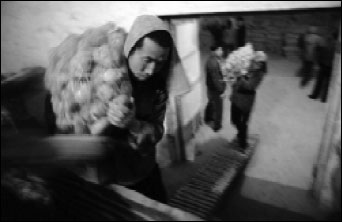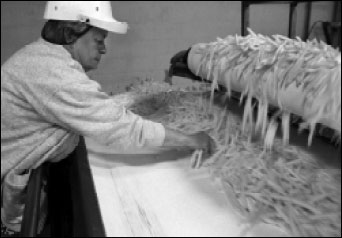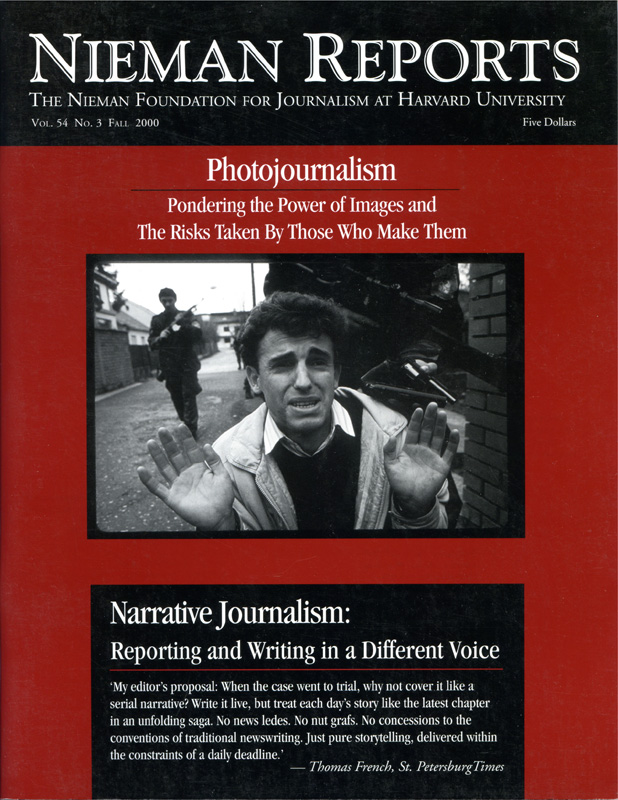
A potato farmer in Dapu, China, about 240 km northwest of Beijing, guides his cart full of manure along a small plot of land and places small piles for fertilization. Simplot hopes to have potatoes grown locally for their plant that opened in Beijing in 1995. Photos by Kathryn Scott-Osler©/The Oregonian.
Classic nonfiction narratives have a protagonist, a quest, and a set of obstacles. I had all three ingredients in 1998, although I confess I didn’t know enough about narrative theory to express it in even these most basic terms.
The protagonist: me, a freshly minted Nieman alumnus, easing back into The Oregonian’s newsroom after a magical year at Harvard.
The quest: to explain to our readers the Asian financial crisis, a looming debacle that appeared remote and forbiddingly technical to most Americans.
The obstacles: The first one emerged immediately in the puzzled expression of an editor, when I announced that to tell this story I wanted to follow French fries halfway around the world.
I imagined that the protagonist of this story-behind-the-story was well qualified. In fact, my credentials were flawed. Sure, I knew a fair amount about Asia from eight years of reporting in the region during its economic boom. And yes, for an English major, I knew at least something about economics after studying at Harvard with professors such as Dwight Perkins and Ezra Vogel. But I had never tried to write a long-form narrative series, let alone the hybrid explanatory narrative that I proposed. Scene setting, for me, was something I did as a cub reporter in pyramid-style stories from the scenes of crimes.
Heck, narrative writing looked easy. Tom Hallman, the master of the form in our newsroom, spun out compelling narratives on everything from a salesman who persisted despite cerebral palsy to a deputy district attorney who prosecuted a drunken driving case. But editors twice rejected my proposal to explain the Asian crisis by tracing the path of a potato from a farmer’s field to a fast-food outlet in the Far East.
The rejections were disappointing because it all made perfect sense to me. French fries were a $2 billion Northwest industry bound to suffer as Asian markets tanked. The fries’ main customers in Asia were members of the region’s emerging middle class, which was crucial not only to economic development but to the growth of democracy. And after all, anyone—even a sleepy morning newspaper reader—can relate to a French fry.
In time an ally emerged, as happens to fortunate protagonists, in the form of Therese Bottomly, a managing editor, who rescued my proposal. Soon Jack Hart, The Oregonian’s writing coach and Bottomly’s colleague as managing editor, surfaced as editor for the project. Hart puzzled over the concept because it didn’t fit the usual narrative format.
There was no main character, unless it was the inanimate spud. He advised picking a particular container of French fries to follow wherever it went. This would at least make the story specific and real.
On a visit to the J.R. Simplot Co. French fry factory, I found a batch of fries headed for Indonesia, the nation hardest hit by the financial downturn. A shipping clerk located the growers of this particular lot, using a computer tracking system established to trace worldwide sources of food poisoning. A colony of Hutterites, members of a Germanic sect reminiscent of the Amish, turned out to have nursed my spuds from seedlings. Gaining access to the remote colony was tricky, but not as difficult as penetrating the public relations walls around McDonald’s, which bought the fries.
I rode to port on the French fry truck, which as luck would have it was driven by a Vietnam veteran. He described Asia during the era before battlefields became trade zones. I interviewed the ship’s captain and met the vessel in Hong Kong, encountering drama during a storm. I winced when McDonald’s diverted this shipment of fries to Singapore, avoiding deteriorating conditions in Indonesia. But I soon realized that the unexpected turn gave my story a good real-world twist.
Photographer Kathryn Scott-Osler and I waded into the dark freezer of a McDonald’s outlet in Singapore to find our potatoes’ code number marked on the boxes. We interviewed customers, who were startled by our interest in French fries as financial clouds whirled around this normally placid city-state.
The French fry narrative began to take form. Still relying on these potatoes as the story’s connective thread, I could explain stark contrasts among countries in a region that can appear homogenous from afar. The story could show that while French fries are the ultimate uniform global product, the worldwide cast of characters producing and marketing them could not be more diverse. The potatos’ journey could take the reader to the heart of the growing Asian crisis.
From Singapore, we traveled on to Indonesia, arriving in time to cover the riots that led ultimately to President Suharto’s resignation. In Jakarta, a Simplot manager paid a wide-eyed trucker to drive a fuel tanker through mobs and fires to power a generator that kept McDonald’s fries frozen.
The Oregonian, a regional paper, lacked foreign bureaus to cover daily developments in the Asian meltdown. But that disadvantage gave us the luxury of stepping back and putting the financial collapse in context for readers who didn’t follow the breaking news. As Curator Bill Kovach said during our Nieman year: “These days, the context is almost as important as the story.”
I caught the last plane out of riottorn Jakarta to head home. Soon I set out to write the story and quickly discovered the writing of long-form narrative journalism can be about as challenging as surviving a revolution. Good storytelling can lull you into thinking that narratives are merely a bunch of color interspersed with facts. Write a piece that way, and you’ll end up with a bedtime story.
Hart helped me outline the piece in scenes and points. Each scene had to have a point, or we cut it. Hart also imposed discipline in limiting the number of characters for maximum effect. He made sure that we constantly oriented the reader in time and place. He curbed my temptation to include fascinating French fry trivia at every turn.
I tried, however crudely, to emulate John McPhee. This was a story about French fries, much as McPhee once wrote a book about oranges. And yet it wasn’t really about French fries. We used the spuds to pull the reader along, but we traveled intentionally out on numerous tangents. Each digression aimed to teach the reader something about the global economy, about currency flows, about the differences between Asian countries or effects of the financial crisis on people in the United States. Creating such a meandering trail was full of risks. Go too far out on a tangent and suddenly you can almost hear a reader say, “Huh? I thought this was a story about French fries. Hey Martha, is ‘Jeopardy’ on yet?”
I discovered that after having completed the outline of a narrative story, I would need to rereport much of the action. Editors who haven’t worked on narrative projects might not realize the amount of time and effort this re-reporting requires. The problem is that a writer reporting a narrative story doesn’t know what scenes will ultimately be used. So I didn’t know until later to ask the farmer what he wore the day he planted these spuds, or what he taught the colony’s kids that morning in German class. I returned to the Hutterite colony and spent a day riding a wheat combine with the farmer. I asked him so many seemingly irrelevant questions that he might well have ejected me into the 104-degree field.
I struggled especially to write reconstructed narrative, the sections in which we worked to recreate scenes that had occurred before I entered the French fry factory and began observing events first hand. I found myself confusing summary narrative, which condenses events, with dramatic narrative, which presents vivid scenes that allow readers to experience the story with the characters. These indelible scenes carry the full force of narrative storytelling, whether fiction or nonfiction. Done well, they pull a reader into a story so far that he forgets his surroundings and remembers the point long after recycling the newspaper. To create such scenes, journalists must think like fiction writers, considering plot, point of view, atmosphere and tone. That’s challenging for those of us reared on traditional news writing.
The narrative approach doesn’t fit every story, or even many stories. And it raises a new set of ethical issues: By seeing events through the eyes of a main character, are we shortchanging other viewpoints? By arranging plot points and scenes, are we bending reality to fit a preconceived narrative structure?
If I had written the story you are now reading in narrative, it might culminate EDITOR'S NOTE
Read won the 1999 Pulitzer Prize for explanatory reporting for his series “The French Fry Connection.”with a scene at the Pulitzer Prize awards luncheon. There I met McPhee, who won a Pulitzer in the same year. But my own conclusion is far from written.
I’ve struggled lately to fuse narrative writing with investigative reporting, a pursuit that makes French fries seem relatively easy. Novelists don’t confront characters who decline to be identified or who announce halfway through the book that they won’t participate.
But daily newspapers can harness the power of narrative writing. Consider the difference between perusing a traditional news account of a hurricane and reading, or viewing, the harrowing scenes of “The Perfect Storm.” The vast gulf between the two approaches contains rich territory for journalists.
For inspiration, I have only to look to my daughter, who was an infant when I chased potatoes through Jakarta’s flaming streets. Jerome Stern, in “Making Shapely Fiction,” says that like a child in a tantrum, when you want everyone’s attention you “make a scene,” using the writer’s full complement of “dialogue, physical reactions, gestures, smells, sounds and thoughts.” At almost three years of age, my daughter resorts less often to this form of expression as she learns to summarize experience in words. But I hope she won’t forget, as I might have, that there are virtues in making a scene.

Simplot uses a storage complex in Zhuo Lu outside of Beijing. The storage holds about 3,000 tons of locally grown potatoes, and this worker earns about nine yuan per day for hauling potatoes on his back and loading them on a truck.

Lola DuPuis has been a Simplot employee for 20 years, sorting through freshly cut potatoes on their way to becoming French fries bound for McDonald’s worldwide.
Richard Read, The Oregonian’s senior writer for international affairs and special projects, reported and wrote “The French Fry Connection,” which can be read at www.pulitzer.org.



